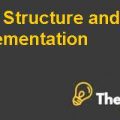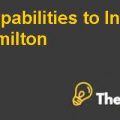Methods that should be considered
The management shall adopt appropriate hedging strategies to avoid its negative impact on the cash flows of the company. Some of the hedging strategies that Nodal Logistics can adopt include the following:
a) Remain uncovered
b) Sensitivity analysis
c) Purchase Forward contracts
d) Purchase put options
e) Cross-currency swap
f) Currency adjustment clause
g) Money market hedge
Expected proceeds from various hedging alternatives
(a) Remain uncovered
If we assume that the exchange rate remains fixed at BRL 1.795/$ then our analysis in Exhibit 1 shows that the cumulative cash flows over the first six years will result a total of $15,126,196, and a present value of $10,279,691. Moreover, if the Brazilian Real appreciates against US Dollar in future, then Nodal Logistics will be enjoying far better position than this but on the other hand if the Brazilian Real depreciates against US Dollar, then the long term cash flows will be scarified.
(b) Sensitivity analysis
Exchange rates are subject to continuous fluctuations over time due to changes in economic conditions and the monitory policy adopted by the government so there is a clear possibility that the exchange rates will appreciate or depreciate over time. So a sensitivity analysis has been performed in order to consider the impact of change in exchange rate on the long term cash flows of the company. Sensitivity analysis has been performed with a fluctuation of ±5.
If we assume that the exchange rate is expected to appreciate against US Dollar at 5% then the results of our analysis in Exhibit 1shows that the cumulative cash flows over the first six years will result a total of $18,554,308 with a present value of $12,500,647 at discount rate of 10%.
On the other hand, if the exchange rate is expected to depreciate against Dollar at 5%, so the cumulative cash flows over the first six years will show a total of $12,261,290 and a present of 8,409,066 at a discount rate of 10%.
(c) Purchase Forward Contracts
Forward contracts allow the company to execute the foreign transaction at designated exchange rate agreed with the bank, which secures the realization of funds and eliminates any uncertainty associated with foreign investments.
The results of our analysis in Exhibit 2 shows that the cash flow proceeds from forward contracts. which will give a total sum of $11,873,198 with a present value of $8,151,170 at a discount rate of 10%.
Nodal Logistics And Custo Brasil Case Solution
(d) Purchase Put Options
Benefit of the options are that the company has the right but not the obligation to purchase the instruments but on the other hand the cost associated with options are particularly high as compared to other hedging instruments which can threaten the cash flows of the organization. Further, our analysis in Exhibit 3 shows that, in the case Nodal Logistics uses the optionof strike rate, the cash flow proceeds over a period of time will generate a total of $10,166,934 with an NPV of $5,408,314 at a discount rate of 10%.
(e) Cross-Currency Swap
A cross-currency swap loan dominated in one country is exchanged against principal and interest payment on loans dominated in the other country. If the Nodal Logistics adopts this hedging instrument then there will be an exchange of US Dollars against Brazilian Real. Nodal Logistics will make Real payment to swap provider in exchange for a principal payment of US Dollar; if the organization adopts this strategy then it will be able to resolve the issue of adverse impact on cash flows.
Nodal Logistics’s US Dollars investment in Brazil is then recorded as Brazilian Real and is matched against the outstanding principal on real loan; hence it will affect the balance of Nodal Logistics balance sheet equally.
(f) Currency Adjustment Clause
Currency Adjustment Clause (CAC), commonly known as risk sharing agreements which are executed with customers in order to eliminate the currency risk on an on-going operational cash flows. This is where the lease rates are linked with exchange rates and the customer will share the relative risk but this proposed clause may not be acceptable to customers and the customers may not be directly willing to bear risk. However, it may also be possible that the customers start to demand additional discount in order to accept the particular risk, which will reduce the overall revenue of the company. Further, the majority of the customers are the multinational companies, which is already suffering from exchange rate fluctuations and such companies may refuse to handle additional burden on lease payments linked with exchange rates......................................
This is just a sample partial case solution. Please place the order on the website to order your own originally done case solution.












